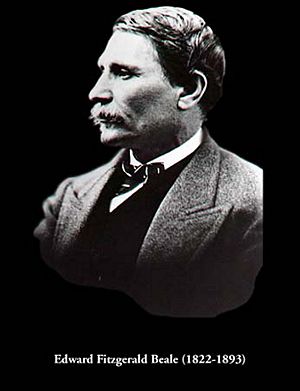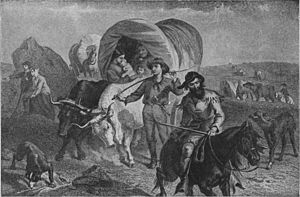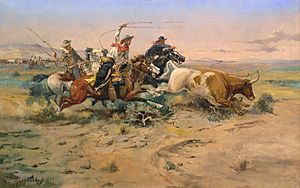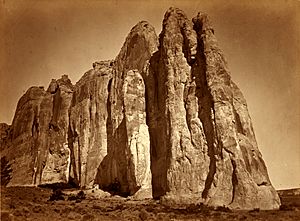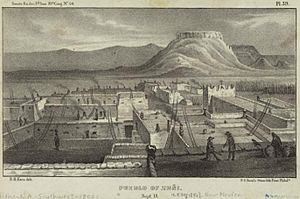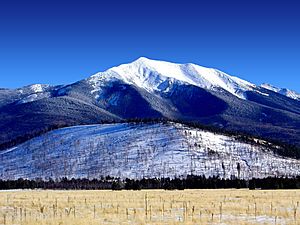Rose–Baley Party facts for kids
The Rose–Baley Party was a group of early American travelers who made history. In 1858, they became the first wagon train of European Americans to travel a new route called Beale's Wagon Road. This path went from Zuni Pueblo, New Mexico all the way to the Colorado River near where Needles, California is today.
The journey began when Leonard John Rose, a rich businessman from Keosauqua, Iowa, decided to move to California. He heard exciting stories from gold miners returning from the West. Rose put together a well-equipped wagon train. It had 20 horses and 200 purebred red Durham cattle. He also had four large covered wagons, each pulled by six oxen.
Rose's group left Iowa in early April. In mid-May, they met up with another group led by Gillum Baley. Baley was a 44-year-old veteran of the Black Hawk War. Together, their combined group had 20 wagons, about 40 men, 50 to 60 women and children, and nearly 500 cattle. A 62-year-old minister named John Udell kept a daily journal. He wrote down where they camped, how far they traveled, and what resources they found.
After traveling more than 1,200 miles in four months, the Rose–Baley Party faced a big challenge. On August 30, 1858, they were attacked as they got ready to cross the Colorado River. Eight people were killed, including five children. Thirteen others were hurt. The travelers fought back and killed some of their attackers. After the attack, they decided not to continue to California. Instead, they turned back and traveled more than 500 miles to Albuquerque, New Mexico.
Contents
Beale's New Road
In October 1857, a team led by Edward Fitzgerald Beale was given a special job. They had to create a new trade route along the 35th parallel. This path would go from Fort Smith, Arkansas to Los Angeles, California. This new path became known as Beale's Wagon Road. It started at Fort Smith and went through Fort Defiance, Arizona. Then it crossed the Colorado River near where Needles, California is now. The place where Beale crossed the river was called Beale's Crossing.
Beale described his new route as the "shortest" and "most level" way to California. He said it had plenty of water and timber. He also noted that the climate was mild and healthy. He believed it was the best way to cross the large desert. Beale suggested that a military fort was needed on the Colorado River. This would help protect travelers. He also asked for money to build bridges and dams for safer travel and water.
Forming the Party
In the summer of 1858, the Rose–Baley Party became the first group of settlers to use Beale's new route. Leonard John Rose (L.J. Rose) started his group with his family of seven. He also had his foreman, Alpha Brown, and his family. Seventeen other workers, called grubstakers, joined them. These workers were given food and a place to stay instead of a salary. Rose was born in Germany in 1827 and moved to the United States when he was eight. He wrote that he was inspired to go to California by stories of its "glorious climate" and "wealth of flowers."
To pay for the trip, Rose sold most of his belongings. He had $30,000 left, which was a lot of money back then. This allowed him to buy many supplies. He bought 20 horses, including valuable Morgan horses. He also bought 200 red Durham cattle, hoping to sell them for a profit in California. Rose got four large covered wagons, each needing six oxen to pull it. Three wagons carried supplies, and one was for Alpha Brown's family. Rose's family traveled in a smaller wagon pulled by two mules.
The Baley and Hedgpeth families joined the journey from northwestern Missouri. They were leaving because of political and money problems. The Kansas–Nebraska Act had caused tension over slavery. Also, the financial Panic of 1857 made many people look for a better life in California. Gillum Baley, a veteran of the Black Hawk War, led their group. They had eight wagons, 62 oxen, 75 cattle, and several riding horses. They also hired workers to help with their animals.
The Long Journey
The Rose company left Iowa in April and traveled to Kansas City, Missouri. In mid-May, they met the Baley company near Durham, Kansas. For safety, the two groups decided to travel together. Their combined group had 20 wagons, 40 men, 50 to 60 women and children, and nearly 500 cattle.
Most travelers going west from the Midwest used the Oregon Trail. But in 1858, the Rose–Baley Party avoided Utah because of concerns about conflict. They took the Santa Fe Trail to New Mexico instead. This southern route added 500 miles to their trip. The Santa Fe Trail had two paths. The Rose–Baley Party chose the Cimarron Cutoff. It was shorter and easier for wagons, but it went through areas where the Comanche and Kiowa people lived.
The wagon train reached Albuquerque, New Mexico on June 23. They got ready for the trip to the Colorado River. They planned to use Beale's Wagon Road from Zuni Pueblo, New Mexico. John Udell, the minister, was worried about this new route. He wrote that it seemed "preposterous" to start such a long journey with so many women and children. But people in Albuquerque, including army officers, told them the new route was shorter and had plenty of food and water. They were also told the area was safe from hostile Native Americans.
The only towns between Albuquerque and San Bernardino, California were the Zuni and Laguna pueblos. The group hired Jose Manuel Savedra, a Mexican guide who had traveled with Beale. They paid him $500 in advance.
The Rose–Baley Party left Albuquerque on June 26. One of Rose's men, Frank Emerdick, drowned while crossing the Rio Grande. They traveled for five days without stopping for Independence Day. On July 5, they reached the Zuni Mountains. Two days later, they crossed the Continental Divide of the Americas. Udell described the road as "smooth and fine." On July 7, they camped near El Morro National Monument, also called Inscription Rock. Several members, including Rose and Udell, carved their names into the stone. This showed they knew they were the first settlers in the area.
On July 10, the party reached Zuni Pueblo. They visited and bought cornmeal and vegetables. This was their last chance to buy supplies until San Bernardino, about 500 miles away. This was likely the first time the Zuni people had seen European women and children. It was also the first time the travelers had seen people with albinism, which was present in the Zuni population. After leaving Zuni Pueblo, they entered new territory. Until then, only Native Americans, explorers, and missionaries had traveled there. The Rose–Baley Party became the first wagon train to use the untested Beale's Wagon Road.
Challenges on Beale's Road
The new road was difficult. Even though Beale had taken a few wagons over it, it was mostly a survey trail. It had faint wagon tracks and occasional stone markers. Some parts followed animal trails. Water was sometimes available, but there were also long stretches without it. From the San Francisco Peaks to the Colorado River, important resources were scarce.
The next water source was Jacob's Well, 36 miles west of Zuni Pueblo. The travelers were careful not to get lost between water stops. They rested at Jacob's Well, where the water was salty but drinkable. Later, they went another 8 miles to Navajo Springs, Arizona, where they camped.
After Navajo Springs, the next water was 40 miles away at the Little Colorado River. In between, they passed through an area now known as Petrified Forest National Park. Several members collected souvenirs of petrified wood. They reached the Little Colorado River near Holbrook, Arizona. The river water was salty, but they dug holes in the riverbank to get clean water. They followed the river for 85 miles to Canyon Diablo.
On July 18, spirits were high. Udell wrote that the group was "harmonious, friendly, and kind." They had traveled 1,112 miles from the Missouri River. The party left the Little Colorado River near Winslow, Arizona. They camped near Canyon Diablo to hunt and find fresh water. By July 24, their guide, Savedra, found water 17 miles away at Walnut Creek. They packed up and traveled at night to avoid the heat. On July 25, they stopped near a spring in the pine forests of the San Francisco Peaks. The cool forests gave them a break from the desert heat.
The Rose–Baley Party enjoyed their camp near Flagstaff, Arizona. They rested and explored. Several members climbed Humphreys Peak, the highest point in Arizona. They were surprised to see snow and ice in late July. Until this point, they had a decent road, good hunting, and steady water. They had seen beautiful scenery and met friendly Native Americans. But soon, conditions would change.
On July 29, Savedra told them the next reliable water was 70 or 80 miles away. This was too far for their animals without water. Some wanted to wait for the rainy season. Udell disagreed, saying they would run out of food. Six men went to search for a closer water source. Two days later, a man reported a spring 15 miles west. But it was too small for everyone. So, they decided to split the wagon train into two groups.
On August 1, the Rose company went west. The Baley company waited a day. The search party found enough springs for the next 50 miles. But then, Savedra said there was no more water for 60 miles. This was too far. The party decided to go back 26 miles to Cataract Creek. Udell was upset, wishing he could go on alone. Their animals were very thirsty. The water at Cataract Canyon was limited and had "wigglers," but they had no choice. By August 9, they lost trust in Savedra. They started scouting for water themselves. They even built wooden barrels to collect water.
On August 13, it rained, which helped a little. Men who had been searching for water returned. They found a good source 40 miles away and another 80 miles away. The next morning, they filled their barrels and left. After traveling almost 24 hours, they reached Partridge Creek. A thunderstorm filled the creek with rainwater. But the next day, they found the rain hadn't reached further. They had to make a dry camp on August 17.
On August 18, after 85 miles without good grass or water, they found a field and a spring. That night, a horse and a mule went missing. Searchers found them in a canyon, where Native Americans shot arrows at them. Savedra saw Natives watching the party the next day. He used sign language to invite them to camp. These were likely Hualapai people. They spoke some Spanish and English. They said the Mohave had stolen the animals.
Rose believed the Hualapai had taken the animals. The next morning, 25 Natives returned the animals at Peach Springs, Arizona. They expected gifts. Udell wrote that they wanted "extravagant rewards." Many stayed in camp, probably hoping to steal. On August 20, 50 more Hualapai arrived, expecting gifts. They left after getting tobacco, trinkets, and food. But then, six oxen were missing. A search team found four dead oxen. The other two were recently killed. That night, the Rose–Baley Party split their wagons again because of water shortages. As they traveled from Peach Springs to the Colorado River, over 100 miles, Natives bothered them. They shot arrows and raided their camp at night.
Colorado River Attack
On August 27, 1858, the Rose–Baley Party reached the Black Mountains. They crossed at Sitgreaves Pass. From the top, they could see the Colorado River. After traveling all night, they stopped to eat. A small group of Mohave warriors approached. They asked how many people were in the wagon train. They also asked if the group planned to stay near the Colorado River. The Mohave seemed friendly and sold them corn and melons. The travelers said they were just passing through to California. This seemed to satisfy the Natives. Many helped the party go down the mountain to the Colorado River. They were now in Mohave country, near Needles, California.
By midnight, the Baley company was behind. They made a mountain camp. Rose and others continued to the Colorado River. They planned to water their animals and build a raft. By noon on August 28, Rose reached some cottonwood trees near the river. There, they met more Mohave, but these were rude. After watering their animals, Rose and his wife, Amanda, went to find a good campsite. An aggressive Mohave touched Amanda, and she ran back to the wagon. Rose ignored it to avoid trouble. Other Mohave bothered Alpha Brown's family. They tried to take his wife's dress and kidnap their son. This danger passed, but many Mohave drove off and killed some of the party's cattle. Then they left the travelers alone.
The next morning, they moved their camp closer to the river. Around noon, 25 warriors and a Mohave sub-chief visited. They heard complaints about the cattle. The chief promised no more harm and said they could cross the river. About an hour later, another chief came. After receiving gifts, he also left. Rose noted that the chief gave them a "searching look," as if he didn't fully believe them. By noon, the party moved their camp even closer to where they planned to cross.
The Attack and Aftermath
On August 30, 1858, around 2 p.m., the travelers heard Alpha Brown's step-daughter, Sallie Fox, screaming. She had seen Mohave warriors nearby. About 300 warriors then shouted war cries and shot arrows into the camp. Rose's foreman, Alpha Brown, was badly wounded. Udell described the arrows as "like a shower." Rose said they were "well armed and the men... ready to receive them." The men fought back, and the women and children ran to the wagons. The fighting lasted about two hours. A Mohave chief leading the attack stepped forward. Gillum Baley, a skilled shooter, shot him. The Mohave warriors took the chief's body and left. Later, some historians wondered if Hualapais were also involved in the attack.
Udell reported that eight members of the Rose–Baley party were killed. Thirteen were wounded. Rose said only 10 horses and 17 cattle remained. All seven members of the Bentner family, including five children, were killed. They were traveling alone from Baley's mountain camp to Rose's river camp. Investigations later showed the Bentners were attacked by Hualapais and some Mohave warriors. The travelers killed about 17 Mohave warriors. In 1859, the U.S. military built Fort Mohave near the battle site.
After the battle, the Rose company discussed what to do. They had little ammunition and fewer men. They decided to go back to Albuquerque, nearly 500 miles away. San Bernardino was closer, but they felt safer going back. They buried Alpha Brown's body in the Colorado River. They had only one wagon and the ambulance left. They chose what to carry and what to leave behind. Those who could rode horses, and the rest walked.
This day all who were left alive of Mr. Rose's party came into camp, bringing melancholy intelligence.
Around 6 p.m., the Rose company began the difficult trip back. The wounded were in one wagon, children in the ambulance, and adults walked. They heard war cries and noises from the Colorado River. The Mohave had found the abandoned supplies and were celebrating. This celebration likely stopped them from following the fleeing wagon train. The travelers were heading to meet the Baley company at their mountain camp.
Images for kids


